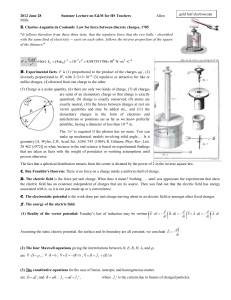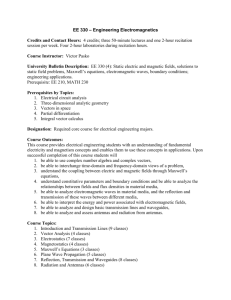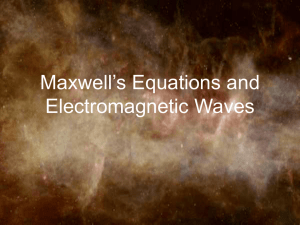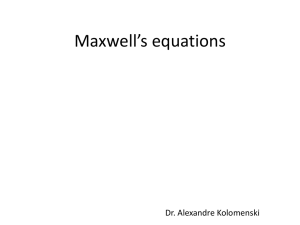Mathematical Tripos, Part IB : Electromagnetism, Dr Natalia Berloff 1
advertisement
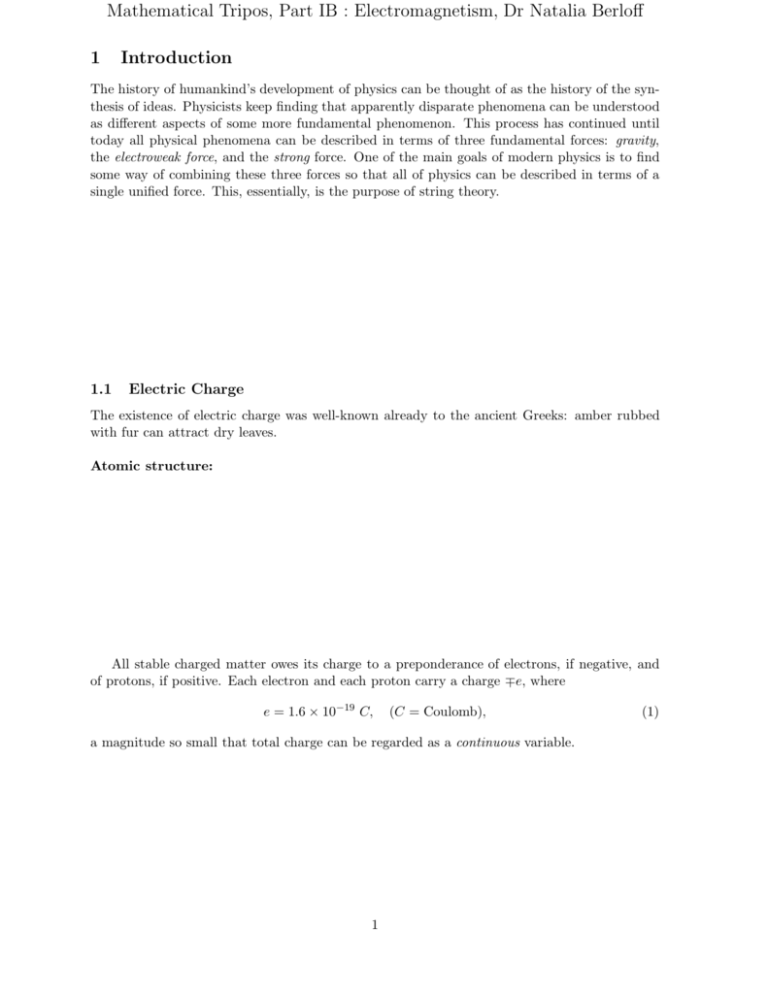
Mathematical Tripos, Part IB : Electromagnetism, Dr Natalia Berloff 1 Introduction The history of humankind’s development of physics can be thought of as the history of the synthesis of ideas. Physicists keep finding that apparently disparate phenomena can be understood as different aspects of some more fundamental phenomenon. This process has continued until today all physical phenomena can be described in terms of three fundamental forces: gravity, the electroweak force, and the strong force. One of the main goals of modern physics is to find some way of combining these three forces so that all of physics can be described in terms of a single unified force. This, essentially, is the purpose of string theory. 1.1 Electric Charge The existence of electric charge was well-known already to the ancient Greeks: amber rubbed with fur can attract dry leaves. Atomic structure: All stable charged matter owes its charge to a preponderance of electrons, if negative, and of protons, if positive. Each electron and each proton carry a charge ∓e, where e = 1.6 × 10−19 C, (C = Coulomb), a magnitude so small that total charge can be regarded as a continuous variable. 1 (1) Fundamental problem of electromagnetic (EM) theory: given electric charges q1 , ...qn (source charges) determine the force they exert on another charge Q (test charge). In general, both the source charges and the test charge are in motion. The solution to this problem is facilitated by the principle of superposition: to determine the force on Q compute the forces Fi due to qi alone, so that Coulomb’s Law: Experiment shows also that, when we consider stationary particles with charges q and Q, then charge Q experiences a force F due to q: F= 1 qQ r̂. 4πǫ0 r 2 (2) Here r̂ a unit vector pointing from q to Q. If qQ is positive (same sign charges) then F is an repulsive force; if negative (opposite sign charges), then it is attractive. 1 The factor is a dimensional quantity (ǫ0 = 8.85 × 10−12 C 2 /N m2 is called the permitivity 4πǫ0 of free space) arising because of our use of SI or Système Internationale units (=MKS, metre, kilogram, second units). Next we consider the force on charge Q due to a set of charges qi . This is given by superposition principle n Q X qi rˆi F= . (3) 4πǫ0 ri 2 i=1 Electric field E(r) of a given distribution of charge is the force exerted on a unit charge placed at r n 1 X qi rˆi . (4) E(r) = F/Q = 4πǫ0 ri 2 i=1 2 Continuous charge distributions. If the charge is distributed continuously over some region, the sum becomes an integral Z 1 1 E(r) = r̂dq. (5) 4πǫ0 r2 The charge can be spread out along a line (dq = λdl′ ), or over a surface (dq = σda′ ) or over a volume (dq = ρdτ ′ ), so that λ(r) is the charge per unit length, σ(r) is the charge per unit area and ρ(r) is the charge per unit volume. For instance, the electric field of a volume charge of density ρ(r) is Example 1. Find the electric field a distance z above the midpoint of a straight line segment of length 2L which carries a uniform line charge λ. 3 1.2 Magnetic field What is the force on the test charge if the source charges are in motion? Experiment: A moving charge generates a magnetic field B. Lorentz force Law: The magnetic force, Fm on a charge Q, moving with velocity v in a magnetic field B, is Fm = Q(v × B). (6) In the presence of both electric and magnetic fields, the net force on Q would be F = Q[E + (v × B)]. 1.3 (7) Electric current The magnetic field B(r) and related forces are due to charges in motion, i.e. to electric currents. So we look next at the idea of electric current. When the flow of charge is distributed throughout a three-dimensional region, we describe it by the volume current density, J = ρv. The total charge per unit time passing through a surface S is called the electric current I through S Z Z J · dS, dS = ndS. (8) J · ndS = I= S S I is also called the charge flux (rate of flow of charge through S). 4 Because the charge is conserved, whatever flows out through the surface must come at the expense of that remaining inside: Z Z d J · dS = − ρdτ (9) dt V S Continuity equation (conservation of charge) Note the meaning of the generic term flux: The flux f of a vector field R through a surface S is defined by Z R · dS. (10) f= S Examples: Flux of the electric field, flux of the magnetic field etc... 1.4 Maxwell’s Equations It was the great achievement of Maxwell to unify the separate subjects electricity and magnetism into a single consistent formalism involving a set of equations (Maxwell’s equations) capable of describing all classical electromagnetic phenomena. For charges and currents in a non-polarisable and non-magnetisable medium, such as the vacuum, these are ∂B = 0 ∂t ∇·B = 0 1 ρ ∇·E = ǫ0 (11) ∇×E + ∇×B = µ0 (J + ǫ0 (12) (13) ∂E ) ∂t (14) where ρ and J are the volume charge and current densities. The constant µ0 (= 4π × 107 N/A2 ) is called the permeability of free space. The last term of (14) features the displacement current postulated by Maxwell in order to achieve a formalism that consistently unified previous theories of electricity and magnetism. Certain more general media can be described by means of a suitable generalisation of the set (11–14) of Maxwell’s equations, but this lies beyond the present course syllabus. 5 Consistency of Maxwell’s Equations. 1.5 Integral forms of Maxwell’s equations Maxwell’s equations involve divs and curls. We can therefore convert them into useful integral forms by integrating over fixed volumes using the divergence theorem, or over fixed surfaces using Stokes’s theorem. Gauss’s Law. Hence 1 Q= ǫ0 Z E · dS. (15) S=∂V The total charge enclosed within the surface equals the flux of E through this surface. Example. Consider a point charge q at rest at O, and let V be the sphere of radius r centred at O. Find E(r). Non-existence of magnetic “charges”. 6 Ampere’s Law (steady current) Hence, in the case of steady current (no time dependence), Stokes’s theorem implies Z B · dr = µ0 C Z J · dS = µ0 I. (16) S Example. Consider an infinite straight wire lying along the z-axis and carrying a current I in the positive direction. Find B(r). Faraday’s Law of induction. Define the electromotive force (or electromotance) acting in C by Z E · dr, (17) E= C and the flux of B through (the open surface) S by Φ= Z B · dS. (18) dΦ . dt (19) S E =− 7 1.6 Scalar and vector potentials, gauge transformations Here we discuss some useful representations for E and B. Consider the first two Maxwell’s equations: E = −∇φ − ∂A . ∂t This tells us that the scalar potential φ only describes the conservative electric field generated by electric charges. The electric field induced by time-varying magnetic fields is non-conservative, and is described by the magnetic vector potential A. ∂A , B = ∇ × A is not unique. Gauge invariance. However, the prescription E = −∇φ − ∂t There are many different potentials which can generate the same fields. It is called gauge invariance. The most general transformation which leaves the E and B fields unchanged in ∂ψ above equations is φ → φ + , A → A − ∇ψ, where ψ (gauge) is an arbitrary function. ∂t We are free to choose the gauge so as to make our equations as simple as possible. Usually the most sensible gauge for the scalar potential is to make it go to zero at infinity: For steady fields the optimum gauge for the vector potential is the so-called Coulomb gauge: ∇ · A = 0. For time-dependent fields a more sensible choice is the so called Lorentz gauge: ∇ · A = −ǫ0 µ0 8 ∂φ . ∂t 1.7 Electromagnetic waves Here we consider Maxwell’s equations in the absence of charges and of currents, e.g. in the vacuum. Thus each (Cartesian) component of E satisfies a wave equation 1 ∂2 2 ∇ − 2 2 E = 0, c ∂t where the wave speed c is given by c2 = (20) 1 . ǫ0 µ 0 (21) Similarly, B satisfies the same wave equation. In other words, each of E(r) and B(r) are propagated as waves of speed c. The values of the quantities ǫ00 and µ0 appropriate to SI units are fixed by experiment, and these values indicate that c = 3 × 108 m/s = the speed of light. (22) Maxwell’s equations with the crucial displacement current term, necessary for consistency, can describe electromagnetic wave phenomena across its entire frequency spectrum: see the Table. For waves of frequency ν, measured in hertz, and wavelength λ, measured in metres, c = λν. Also, in quantum theory, the energy of a quantum of given frequency ν is E = hν, where h is Planck’s constant. (One hertz equals one cycle per second). radiation γ X-rays ultra-violet visible light Frequency spectrum ν λ radiation 1019 10−11 infra-red 1018 10−10 µ-wave 1016 10−8 mm 15 −7 10 10 radio 9 ν 1014 1013 1011 106 λ 10−6 10−5 10−3 102 1.8 Discontinuity formulas Here we collect, for easy reference but without discussion at this stage a class of formulas that logically belong together but whose occurrences are scattered throughout several sections of the course material. a). Let S carry charge density σ per unit area. Then 1 σ ǫ0 = 0. n · E|+ − = (23) n×E|+ − (24) b). Let S carry current density s per unit length (charge crossing unit length in S in unit time). n · B|+ − = 0 (25) n×B|+ − (26) = µ0 s. The correspondence between Maxwell’s equations and the discontinuity formulas is clear: ∂ terms, and replace ∇(...) by n(...)|+ drop −. ∂t Force per unit area on S In case (a), consider only the special case when E± only have normal components n·E± = E± . Then the force per unit area on a surface S (carrying surface charge σ) has magnitude 1 σ(E+ + E− ). 2 (27) In case (b), consider only the special case in which B± only have tangential components B± . Then the force per unit area on a surface S (carrying surface current s) is normal to S, and has magnitude 1 s(B+ + B− ). (28) 2 We do not prove the results (27) and (28); the most convenient method of proof lies outside the scope of this course. 10

